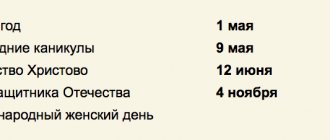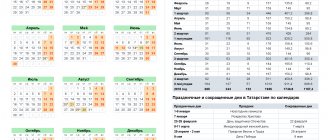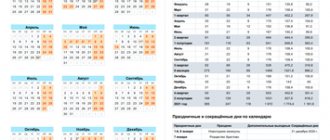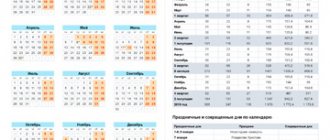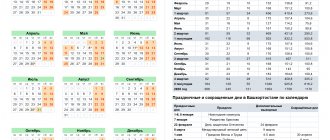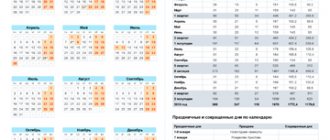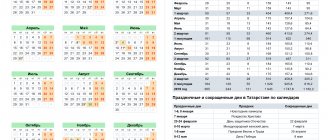I quarter 2016
January
| Mon | VT | SR | Thu | PT | SB | Sun |
| 1 | 2 | 3 | ||||
| 4 | 5 | 6 | 7 | 8 | 9 | 10 |
| 11 | 12 | 13 | 14 | 15 | 16 | 17 |
| 18 | 19 | 20 | 21 | 22 | 23 | 24 |
| 25 | 26 | 27 | 28 | 29 | 30 | 31 |
February
| Mon | VT | SR | Thu | PT | SB | Sun |
| 1 | 2 | 3 | 4 | 5 | 6 | 7 |
| 8 | 9 | 10 | 11 | 12 | 13 | 14 |
| 15 | 16 | 17 | 18 | 19 | 20 | 21 |
| 22 | 23 | 24 | 25 | 26 | 27 | 28 |
| 29 |
March
| Mon | VT | SR | Thu | PT | SB | Sun |
| 1 | 2 | 3 | 4 | 5 | 6 | |
| 7 | 8 | 9 | 10 | 11 | 12 | 13 |
| 14 | 15 | 16 | 17 | 18 | 19 | 20 |
| 21 | 22 | 23 | 24 | 25 | 26 | 27 |
| 28 | 29 | 30 | 31 |
Production calendar 2016
COMMENTS on the production calendar for 2016
The production calendar shows the standard working hours for months, quarters and 2016 as a whole for 40-, 36- and 24-hour work weeks, as well as the number of working days and days off for a five-day work week with two days off.
Along with the normal working hours, which cannot exceed 40 hours per week (Article 91 of the Labor Code of the Russian Federation - Labor Code of the Russian Federation), and reduced working hours (Article 92 of the Labor Code of the Russian Federation), other working time regimes are applied. These include: part-time work (Article 93 of the Labor Code of the Russian Federation), irregular working hours (Article 101 of the Labor Code of the Russian Federation), flexible working hours (Article 102 of the Labor Code of the Russian Federation), shift work (Article 103 of the Labor Code of the Russian Federation), summarized working hours (Article 104 of the Labor Code of the Russian Federation), division into parts of the working day (Article 105 of the Labor Code of the Russian Federation).
Shortened working hours are established for workers employed in jobs with harmful and (or) dangerous working conditions, for certain categories of medical and teaching workers, for workers under 18 years of age, disabled workers, etc.
According to Article 112 of the Labor Code of the Russian Federation (as amended by Federal Law No. 35-FZ of April 23, 2012) <1> non-working holidays in the Russian Federation are:
———————————
<1> Collection of legislation of the Russian Federation, 2012, N 18, art. 2127; see also Bulletin of Labor and Social Legislation of the Russian Federation, 2012, No. 5, p. 114 - 115.
January 1, 2, 3, 4, 5, 6 and 8 — New Year holidays; January 7—Christmas Day; February 23 - Defender of the Fatherland Day; March 8—International Women's Day; May 1 - Spring and Labor Day; May 9 - Victory Day; June 12—Russia Day; November 4 is National Unity Day.
The Labor Code of the Russian Federation establishes that if a day off coincides with a non-working holiday, the day off is transferred to the next working day after the holiday. The exception is weekends that coincide with non-working holidays in January. The changes made to Art. 112 of the Labor Code of the Russian Federation, Federal Law No. 35-FZ dated April 23, 2012, provides that the Government of the Russian Federation has the right to transfer two days off from the number of days off that coincide with non-working January holidays to other days in the next calendar year.
In accordance with part five of Art. 112 of the Labor Code of the Russian Federation, for the purpose of rational use by employees of weekends and non-working holidays, weekends may be transferred to other days by the Government of the Russian Federation. At the same time, the procedure for transferring days off is clearly regulated. It has been established that the regulatory legal act of the Government of the Russian Federation on the transfer of days off to other days in the next calendar year is subject to official publication no later than a month before the start of the corresponding calendar year. The adoption of normative legal acts on the transfer of days off to other days during the calendar year is permitted subject to the official publication of these acts no later than two months before the calendar date of the established day off.
Decree of the Government of the Russian Federation of September 24, 2015 N 1017 “On the transfer of days off in 2016” <1> defines specific dates for the transfer of rest days.
———————————
<1> Collection of legislation of the Russian Federation, 2015, N 40, art. 5558; see also Bulletin of Labor and Social Legislation of the Russian Federation, 2015, No. 10, p. 101.
January, according to established tradition, is the month with the largest number of holidays. In January there are 16 holidays and weekends and 15 working days. Due to the coincidence of non-working holidays on January 2 and 3 with Saturday and Sunday, the transfer of days off is provided from Saturday, January 2 to Tuesday, May 3, from Sunday, January 3 to Monday, March 7.
Thus, taking into account the postponement of days off in 2016, the period of the New Year holidays for workers, together with the celebration of the Nativity of Christ, will be 10 days - from January 1 to January 10, 2016. After such a long rest, workers are scheduled to return to work on Monday, January 11.
In February 2016, the duration of rest for employees associated with the celebration of Defender of the Fatherland Day will be 3 days - from February 21 to 23, the Saturday day off on February 20 has been moved to Monday, February 22, which is a pre-holiday shortened working day.
In March, in connection with the celebration of International Women's Day, the duration of workers' rest will be 4 days - from March 5 to 8, which is due to the weekend preceding the holiday.
Due to the postponement of the day off from Saturday, January 2 to Tuesday, May 3, on the May Day holiday, employees will rest for 4 days - from April 30 to May 3, and with the celebration of Victory Day, 3 days - from May 7 to 9. In total, in May the number of holidays and weekends will be 12 days.
In June 2016, the rest period associated with the celebration of Russia Day will be from June 11 to June 13, i.e. 3 days, the last of which is an additional day of rest due to the coincidence of a holiday non-working day on June 12 with a Sunday non-working day.
For all transfers, compliance with Art. 110 of the Labor Code of the Russian Federation, according to which the duration of weekly continuous rest should not be less than 42 hours.
Federal Law of July 22, 2008 N 157-FZ Article 91 of the Labor Code of the Russian Federation was supplemented with part three as follows:
“The procedure for calculating the norm of working time for certain calendar periods (month, quarter, year) depending on the established duration of working time per week is determined by the federal executive body exercising the functions of developing state policy and legal regulation in the field of labor.” <1>
———————————
<1> Collection of legislation of the Russian Federation, 2008, N 30 (part 1), art. 3613.
Currently, there is a procedure for calculating working time standards for certain calendar periods of time (month, quarter, year) depending on the established duration of working hours per week, approved by order of the Ministry of Health and Social Development of Russia dated August 13, 2009 N 588n <1>.
———————————
<1> Order of the Ministry of Health and Social Development of Russia dated August 13, 2009 N 588n “On approval of the Procedure for calculating the norm of working time for certain calendar periods of time (month, quarter, year) depending on the established duration of working time per week” (Bulletin of Labor and Social Legislation RF, 2009, N 10, pp. 58 - 59).
In accordance with this Procedure, this norm is calculated according to the estimated schedule of a five-day working week with two days off on Saturday and Sunday, based on the duration of daily work (shift), for example, with a 40-hour work week - 8 hours, with a work week of 36 hours it will be 7.2 hours; with a 24-hour work week - 4.8 hours.
The length of the working day or shift immediately preceding a non-working holiday is reduced by one hour.
In 2016, such shortened working days are 2 days - February 20 and November 3.
The standard working time calculated in the specified order applies to all work and rest regimes.
In organizations, when developing a work schedule, as a rule, annual, semi-annual, quarterly and monthly working hours are used.
In 2016, with a five-day working week with two days off, there will be 247 working days, including 2 working days shortened by one hour, and 119 weekends and non-working holidays.
The annual working hours in 2016 will be:
- with a 40-hour work week - 1974 hours (8 hours x 247 days - 2 hours);
- with a 36-hour work week - 1776.4 hours (7.2 hours x 247 days - 2 hours);
- with a 24-hour work week - 1183.6 hours (4.8 hours x 247 days - 2 hours).
An example of calculating the monthly standard of working time is its determination for February 2016. This month, with a five-day working week with two days off, there will be 20 working days, including one working day shortened by one hour on February 20, and 9 days off and non-working holidays days.
Working hours this month will be:
- with a 40-hour work week - 159 hours (8 hours x 20 days - 1 hour);
- with a 36-hour work week - 143 hours (7.2 hours x 20 days - 1 hour);
- with a 24-hour work week - 95 hours (4.8 hours x 20 days - 1 hour).
In a number of cases, for example, to calculate wages, the average monthly number of hours is used, which in 2016 will be:
- with a 40-hour work week - 164.5 hours (1974 hours: 12 months);
- with a 36-hour work week - 148 hours (1776.4 hours: 12 months);
- with a 24-hour work week - 98.6 hours (1183.6 hours: 12 months).
Annual and monthly working time standards play an important role in the organization of wages; they are used to calculate hourly tariff rates.
It should be noted that taking into account annual paid holidays, the duration of which for most workers is 28 calendar days, including 20 working days, the rest time for workers is much longer. The number of working days of an individual employee in a year will be 227 (247 - 20) days and, accordingly, 139 weekends and holidays (366 - 227), i.e. almost 40% of the total number of days of the year. And if we take into account that a number of categories of workers have extended annual leave, then the total number of rest days for workers in our country is significantly higher than in many foreign countries.
II quarter 2016
April
| Mon | VT | SR | Thu | PT | SB | Sun |
| 1 | 2 | 3 | ||||
| 4 | 5 | 6 | 7 | 8 | 9 | 10 |
| 11 | 12 | 13 | 14 | 15 | 16 | 17 |
| 18 | 19 | 20 | 21 | 22 | 23 | 24 |
| 25 | 26 | 27 | 28 | 29 | 30 |
May
| Mon | VT | SR | Thu | PT | SB | Sun |
| 1 | ||||||
| 2 | 3 | 4 | 5 | 6 | 7 | 8 |
| 9 | 10 | 11 | 12 | 13 | 14 | 15 |
| 16 | 17 | 18 | 19 | 20 | 21 | 22 |
| 23 | 24 | 25 | 26 | 27 | 28 | 29 |
| 30 | 31 |
June
| Mon | VT | SR | Thu | PT | SB | Sun |
| 1 | 2 | 3 | 4 | 5 | ||
| 6 | 7 | 8 | 9 | 10 | 11 | 12 |
| 13 | 14 | 15 | 16 | 17 | 18 | 19 |
| 20 | 21 | 22 | 23 | 24 | 25 | 26 |
| 27 | 28 | 29 | 30 |
III quarter 2016
July
| Mon | VT | SR | Thu | PT | SB | Sun |
| 1 | 2 | 3 | ||||
| 4 | 5 | 6 | 7 | 8 | 9 | 10 |
| 11 | 12 | 13 | 14 | 15 | 16 | 17 |
| 18 | 19 | 20 | 21 | 22 | 23 | 24 |
| 25 | 26 | 27 | 28 | 29 | 30 | 31 |
August
| Mon | VT | SR | Thu | PT | SB | Sun |
| 1 | 2 | 3 | 4 | 5 | 6 | 7 |
| 8 | 9 | 10 | 11 | 12 | 13 | 14 |
| 15 | 16 | 17 | 18 | 19 | 20 | 21 |
| 22 | 23 | 24 | 25 | 26 | 27 | 28 |
| 29 | 30 | 31 |
September
| Mon | VT | SR | Thu | PT | SB | Sun |
| 1 | 2 | 3 | 4 | |||
| 5 | 6 | 7 | 8 | 9 | 10 | 11 |
| 12 | 13 | 14 | 15 | 16 | 17 | 18 |
| 19 | 20 | 21 | 22 | 23 | 24 | 25 |
| 26 | 27 | 28 | 29 | 30 |
IV quarter 2016
October
| Mon | VT | SR | Thu | PT | SB | Sun |
| 1 | 2 | |||||
| 3 | 4 | 5 | 6 | 7 | 8 | 9 |
| 10 | 11 | 12 | 13 | 14 | 15 | 16 |
| 17 | 18 | 19 | 20 | 21 | 22 | 23 |
| 24 | 25 | 26 | 27 | 28 | 29 | 30 |
| 31 |
November
| Mon | VT | SR | Thu | PT | SB | Sun |
| 1 | 2 | 3 | 4 | 5 | 6 | |
| 7 | 8 | 9 | 10 | 11 | 12 | 13 |
| 14 | 15 | 16 | 17 | 18 | 19 | 20 |
| 21 | 22 | 23 | 24 | 25 | 26 | 27 |
| 28 | 29 | 30 |
December
| Mon | VT | SR | Thu | PT | SB | Sun |
| 1 | 2 | 3 | 4 | |||
| 5 | 6 | 7 | 8 | 9 | 10 | 11 |
| 12 | 13 | 14 | 15 | 16 | 17 | 18 |
| 19 | 20 | 21 | 22 | 23 | 24 | 25 |
| 26 | 27 | 28 | 29 | 30 | 31 |
Working hours standards in 2016
The production calendar allows you to quickly calculate the number of working hours for calculating wages, vacation pay, and sick leave.
| Month / Quarter / Year | Amount of days | Working time (hour) | ||||
| Calendar | workers | Weekends | 40 hours/week | 36 hours/week | 24 hours/week | |
| January | 31 | 15 | 16 | 120 | 108 | 72 |
| February | 29 | 20 | 9 | 159 | 143 | 95 |
| March | 31 | 21 | 10 | 168 | 151.2 | 100.8 |
| April | 30 | 21 | 9 | 168 | 151.2 | 100.8 |
| May | 31 | 19 | 12 | 152 | 136.8 | 91.2 |
| June | 30 | 21 | 9 | 168 | 151.2 | 100.8 |
| July | 31 | 21 | 10 | 168 | 151.2 | 100.8 |
| August | 31 | 23 | 8 | 184 | 165.6 | 110.4 |
| September | 30 | 22 | 8 | 176 | 158.4 | 105.6 |
| October | 31 | 21 | 10 | 168 | 151.2 | 100.8 |
| November | 30 | 21 | 9 | 167 | 150.2 | 99.8 |
| December | 31 | 22 | 9 | 176 | 158.4 | 105.6 |
| 1st quarter | 91 | 56 | 35 | 447 | 402.2 | 267.8 |
| 2nd quarter | 91 | 61 | 30 | 488 | 439.2 | 292.8 |
| 3rd quarter | 92 | 66 | 26 | 528 | 475.2 | 316.8 |
| 4th quarter | 92 | 64 | 28 | 511 | 459.8 | 306.2 |
| 2016 | 366 | 247 | 119 | 1974 | 1776.4 | 1183.6 |
Production calendar for 2016 with holidays and days off
In Art. 112 of the Labor Code of the Russian Federation you can see a list of officially established non-working holidays.
There are 14 of them in total. You can often hear another name for the holidays - “red days of the calendar”. Let's take a closer look at the 2016 production calendar with holidays :
- January.
The numbers from 1st to 6th, as well as January 8th, are holiday days for the New Year. January 7 is a holiday.
- February.
This month marks the men's holiday - February 23. Saturday the 20th is a working day for the rest on Monday the 22nd. At the same time, the duration of the working Saturday is also reduced by 1 hour.
- March.
And in March there is a world women's holiday - the 8th. Monday, the 7th, is also a day of rest, as January 3 is postponed to it.
- May.
There are 2 holidays in May - the 1st and 9th. Moreover, May 1st falls on a Sunday and for this reason is postponed to May 2nd. And on the 3rd, employees will rest for January 2nd.
- June.
In the first month of summer there is 1 holiday (12th), which falls on Sunday and is transferred to Monday, 13th.
- November.
The 4th is a holiday, so Thursday the 3rd should be shortened by 1 hour.
- December.
The 31st Saturday in December is not a public holiday, so there are only 9 regular weekends this month.
Non-working holidays
Non-working holidays in the Russian Federation are specified in Article 112 of the Labor Code of the Russian Federation; in addition, they can be supplemented by combining or postponing weekends. Such additional holiday dates are approved by Government decree for each year.
The procedure for postponing weekends in 2016 was approved by Government Decree No. 1017 of September 24, 2015:
- from Saturday January 2 to Tuesday May 3;
- from Sunday January 3 to Monday March 7;
- from Saturday 20 February to Monday 22 February.
Non-working holidays in 2016 are:
| Month | Days of the month | Holiday |
| January | 1, 2, 3, 4, 5, 6, 8 | New Year holidays |
| January | 7 | Nativity |
| February | 23 | Defender of the Fatherland Day |
| March | 8 | International Women's Day |
| May | 1 | Labour Day |
| May | 9 | Victory Day |
| June | 12 | Russia Day |
| November | 4 | National Unity Day |
Pre-holiday days in 2016 are February 20 and November 3. The duration of the working day or shift immediately preceding a non-working holiday is reduced by one hour (Article 95 of the Labor Code of the Russian Federation).
Production calendar with weeks with a five-day working week for 2016.
The five-day week is one of the most common types of working week. It has found wide application in various enterprises and institutions. A five-day work schedule is especially typical for the office sector.
In the five-day mode they work:
- organizations and institutions of the public sector (state-owned, autonomous, budgetary institutions, public authorities);
- accounting;
- credit institutions, among which there may be exceptions: often large banks prefer to have several working offices on a Saturday;
- healthcare institutions, but there are exceptions among them;
- kindergartens;
- and many others.
A five-day week involves a 5-day work schedule from Monday to Friday and 2 days of rest (Saturday and Sunday).
A production calendar is necessary to record the time actually worked by employees in the company. Let us remember that this is the direct responsibility of the organization.
Find out the features of working time recording from our article “Employees’ working time recording schedule for 2016.”
Working time, expressed in hours, in 2016 will be:
- 1974 hours for a 40 hour week;
- 1776.4 hours for a weekly load of 36 hours.
- and 1183.6 hours for the shortest 24-hour week.
Commentary on the production calendar
Working time standards were approved by Order of the Ministry of Health and Social Development of the Russian Federation dated August 13, 2009 N 588n. According to it, the standard working time is calculated according to the estimated schedule of a five-day working week with two days off on Saturday and Sunday based on the duration of daily work (shift):
- with a 40-hour work week - 8 hours;
- if the working week is less than 40 hours, the number of hours obtained by dividing the established working week by five days.
We have already calculated working hours in hours for 2016 for a week with 40-hour, 36-hour and 24-hour employment (see table of standard working hours), but here we will also indicate the calculation algorithm if in your case the working hours are different quantity.
The standard working time in a particular month is calculated as follows:
- The length of the working week (40, 38, 35, 30, 25, etc. hours) is divided by 5 (for a five-day working week);
- Multiplied by the number of working days according to the calendar of the five-day working week of the selected month;
- From the resulting number of hours, you need to subtract the number of hours per year by which working hours are reduced on the eve of non-working holidays.
Example calculation for June 2016 with a 40-hour week:
40/5 = 8 hours of working time per working day * 21 working days in a month = 168 hours.
Example calculation for September 2016 with a 36-hour week:
36/5 = 7.2 hours of working time per working day * 22 working days in a month = 158.4 hours.
Example calculation for August 2016 with a 24-hour week:
24/5 = 4.8 hours of working time per working day * 23 working days in a month = 110.4 hours.
Printable report card for 2016
This table with dates has the usual appearance for us with weekends and holidays marked in red. The main difference between the 2016 production calendar, approved by the Russian government, and its simple analogue is the availability of information:
- on the number of working days, days off and holidays;
- the standard time that an employee must work, taking into account the hourly duration of the work week (40, 36 and 24 hours).
For each new year, a new calendar is compiled. The necessary information is provided there monthly. Then it is summarized for each quarter, half year and year.
Archive of production calendars
Production calendar for 2015 Production calendar for 2014 Production calendar for 2013 Production calendar for 2012 Production calendar for 2011 Production calendar for 2010 Production calendar for 2009 Production calendar for 2008 Production calendar for 2007 Production calendar for 2006 Production calendar for 2005 Production calendar for 2004 Production calendar for 2003 Production calendar for 2002 Production calendar for 2001 Production calendar for 2000 Production calendar for 1999 Production calendar for 1998 Production calendar for 1997 Production calendar for 1996 Production calendar for 1995 Production calendar for 1994 Production calendar for 1993
Download for free in Excel and print the production calendar for 2016
The production calendar should always be at hand for the accountant who is involved in payroll calculations. Knowing working days, weekends and holidays will help to avoid errors when calculating wages, for example, it will tell you about double pay for going to work on weekends and holidays, calculating vacation if it falls on non-working holidays, and so on.
Find out how to correctly calculate vacation pay for an employee whose vacation falls on a holiday from our article “How to calculate vacation if it falls on a holiday?”
The ability to download the 2016 production calendar will be very convenient to place in front of you in a visual printed format.
The production calendar for 2016 can be downloaded for free on our website.
